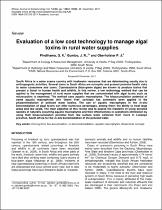 ResearchSpace
ResearchSpace
Evaluation of a low cost technology to manage algal toxins in rural water supplies
JavaScript is disabled for your browser. Some features of this site may not work without it.
- ResearchSpace
- →
- Research Publications/Outputs
- →
- Journal Articles
- →
- View Item
| dc.contributor.author |
Pindihama, GK

|
|
| dc.contributor.author |
Gumbo, JR

|
|
| dc.contributor.author |
Oberholster, Paul J

|
|
| dc.date.accessioned | 2012-01-10T08:37:37Z | |
| dc.date.available | 2012-01-10T08:37:37Z | |
| dc.date.issued | 2011-12 | |
| dc.identifier.citation | Pindihama, G.K., Gumbo, J.R. and Oberholster, P.J. 2011. Evaluation of a low cost technology to manage algal toxins in rural water supplies. African Journal of Biotechnology, Vol 10(86), pp 19883-19889 | en_US |
| dc.identifier.issn | 1684-5315 | |
| dc.identifier.uri | http://www.academicjournals.org/AJB/PDF/pdf2011/30DecSpecial%20Review/Pindihama%20et%20al.pdf | |
| dc.identifier.uri | http://hdl.handle.net/10204/5459 | |
| dc.description | Copyright: Academic Journals | en_US |
| dc.description.abstract | South Africa is a water scarce country with freshwater resources that are deteriorating mostly due to anthropogenic activities. Several dams in South Africa are eutrophic and present potential health risks to water consumers and users. Cyanobacteria (blue-green algae) are known to produce toxins that present a threat to human health and wildlife. In this review, a low technology method that can be applied to the management of rural water supplies that are contaminated with algal toxins such as microcystins is examined. The method uses aquatic macrophytes. The bioaccumulation potential of some aquatic macrophytes (the ‘Green liver’ concept) has commonly been applied in the phytoremediation of polluted water bodies. The use of aquatic macrophytes in the in-situ bioremediation of algal toxins can offer numerous advantages, among them; the ability to treat large areas and low costs. The main objective of this review was to assess the feasibilty of using selected species of naturally occurring aquatic macrophytes and their effectiveness in cyanotoxin elimination by using their bioaccumulation potential from raw surface water collected from rivers in Limpopo province, South Africa for the in-situ bioremediation of the polluted water. | en_US |
| dc.language.iso | en | en_US |
| dc.publisher | Academic Journals | en_US |
| dc.relation.ispartofseries | Workflow request;7847 | |
| dc.subject | Microcystins | en_US |
| dc.subject | Bio-accumulation | en_US |
| dc.subject | In-situ bioremediation | en_US |
| dc.subject | Aquatic macrophytes | en_US |
| dc.subject | Green liver concept | en_US |
| dc.subject | South African water scarcity | en_US |
| dc.subject | South African Limpopo province | en_US |
| dc.subject | Biotechnology | en_US |
| dc.subject | Low cost technology | en_US |
| dc.subject | Algal toxins | en_US |
| dc.subject | Rural water supplies | en_US |
| dc.title | Evaluation of a low cost technology to manage algal toxins in rural water supplies | en_US |
| dc.type | Article | en_US |
| dc.identifier.apacitation | Pindihama, G., Gumbo, J., & Oberholster, P. J. (2011). Evaluation of a low cost technology to manage algal toxins in rural water supplies. http://hdl.handle.net/10204/5459 | en_ZA |
| dc.identifier.chicagocitation | Pindihama, GK, JR Gumbo, and Paul J Oberholster "Evaluation of a low cost technology to manage algal toxins in rural water supplies." (2011) http://hdl.handle.net/10204/5459 | en_ZA |
| dc.identifier.vancouvercitation | Pindihama G, Gumbo J, Oberholster PJ. Evaluation of a low cost technology to manage algal toxins in rural water supplies. 2011; http://hdl.handle.net/10204/5459. | en_ZA |
| dc.identifier.ris | TY - Article AU - Pindihama, GK AU - Gumbo, JR AU - Oberholster, Paul J AB - South Africa is a water scarce country with freshwater resources that are deteriorating mostly due to anthropogenic activities. Several dams in South Africa are eutrophic and present potential health risks to water consumers and users. Cyanobacteria (blue-green algae) are known to produce toxins that present a threat to human health and wildlife. In this review, a low technology method that can be applied to the management of rural water supplies that are contaminated with algal toxins such as microcystins is examined. The method uses aquatic macrophytes. The bioaccumulation potential of some aquatic macrophytes (the ‘Green liver’ concept) has commonly been applied in the phytoremediation of polluted water bodies. The use of aquatic macrophytes in the in-situ bioremediation of algal toxins can offer numerous advantages, among them; the ability to treat large areas and low costs. The main objective of this review was to assess the feasibilty of using selected species of naturally occurring aquatic macrophytes and their effectiveness in cyanotoxin elimination by using their bioaccumulation potential from raw surface water collected from rivers in Limpopo province, South Africa for the in-situ bioremediation of the polluted water. DA - 2011-12 DB - ResearchSpace DP - CSIR KW - Microcystins KW - Bio-accumulation KW - In-situ bioremediation KW - Aquatic macrophytes KW - Green liver concept KW - South African water scarcity KW - South African Limpopo province KW - Biotechnology KW - Low cost technology KW - Algal toxins KW - Rural water supplies LK - https://researchspace.csir.co.za PY - 2011 SM - 1684-5315 T1 - Evaluation of a low cost technology to manage algal toxins in rural water supplies TI - Evaluation of a low cost technology to manage algal toxins in rural water supplies UR - http://hdl.handle.net/10204/5459 ER - | en_ZA |





